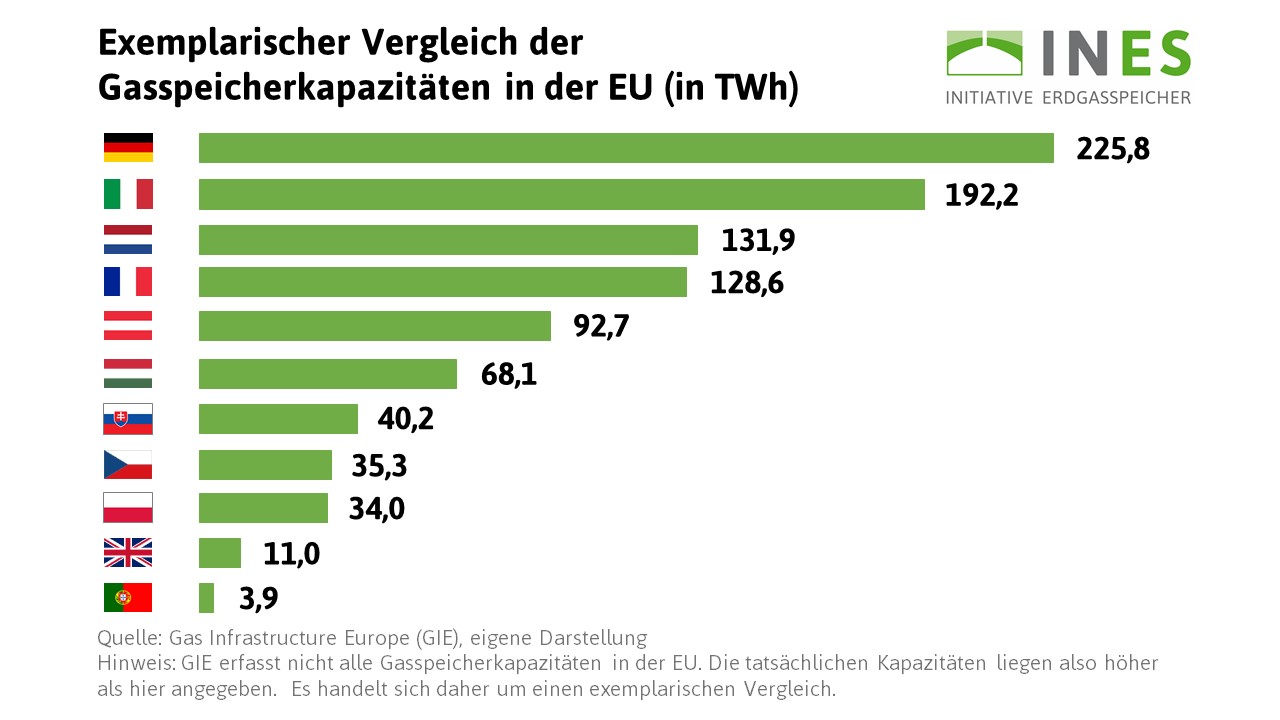

The existing infrastructure of underground and above-ground storage facilities in Germany can store large quantities of gas. Around the clock, about a quarter of the German annual demand for gas is distributed across the country for industry, commerce and private consumers. Storage makes a valuable contribution to the success of Germany as a business location and to safeguarding jobs.
The total capacity for injection and withdrawal from German gas storage facilities is around 23 billion cubic meters of gas. Germany ranks fourth among the world’s largest storage countries. Only in the US, Ukraine and Russia there are even greater capacities.
The share of German gas storage facilities of the gas storage capacity of the European Union is about one quarter. Overall, Germany can therefore draw on the largest gas storage volumes of all EU countries. The size of each facility is different. Among other things, it depends on geological conditions and the type of storage.
A comprehensive overview of the daily capacities of gas storage facilities in Germany and other European countries can be found on the transparency website AGSI+ of Gas Infrastructure Europe, the association of gas infrastructure operators in Europe.


Germany has relatively little own gas reserves. Only about one tenth of Germany’s gas consumption is therefore covered by German gas production. The country therefore must ensure its gas supply primarily through imports.
German gas storage facilities play an important role in security of supply and price stability. They compensate for fluctuations in the consumption of gas and relieve the gas networks – especially if customers demand a lot of gas for heating at the same time in winter.
Gas storage thus acts as a kind of buffer system for the gas market, in order to compensate for daily and seasonal consumption peaks. Gas storage facilities ensure a reliable supply even in the case of extreme gas demand or supply bottlenecks. On cold winter days, up to 60 percent of gas consumption in Germany is covered by German storage. In the particularly cold February 2018, an average of 2,300 gigawatt hours of gas per day was taken from the storage facilities. In the top, gas storage even with 2,700 gigawatt hours per day secured the supply.
However, the value of gas storage for the gas market is not limited to these properties. Gas storage facilities have three levels of added value: the commercial value, the system value and the insurance value.
The gas storage facilities will continue to be of great importance for the energy supply in Germany. They increase the economic efficiency because they significantly reduce the need to construct new gas networks. In conjunction with the power-to-gas technology, they also provide a central storage solution for the energy transition.
The storage volume of an underground storage is the sum of its working gas and cushion gas volumes. The so-called cushion gas serves as a pressure buffer, which should maintain the minimum pressure in the facility. It remains as a residual gas permanently in storage. The gas that is put into or taken out of storage is called working gas – it is intended for consumption.
For the storage of natural gas in a gas storage, the gas is first filtered, measured, compressed and then pressed under high pressure into the storage. The resulting overpressure makes it easier to reversely take out gas again. Two processes are necessary for filling: Firstly, the reheating of the gas, which has now cooled down considerably due to the pressure loss, in the conveyor system. On the other hand, gas drying in drying towers, i.e. the withdrawal of water absorbed during storage, is a necessary procedure before the gas can be fed into supply networks.